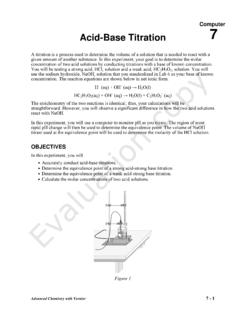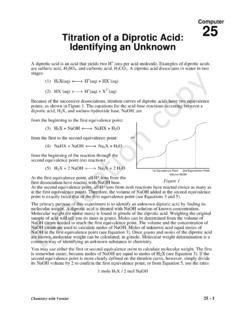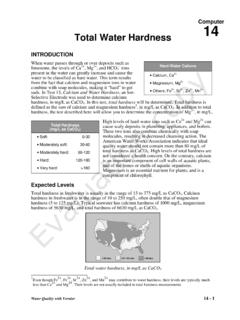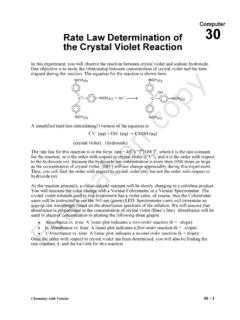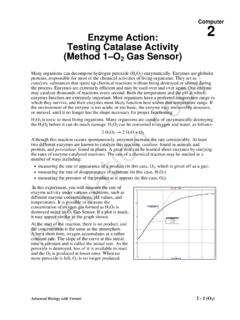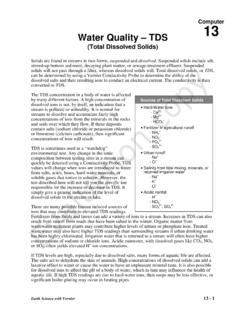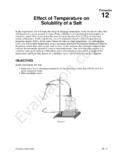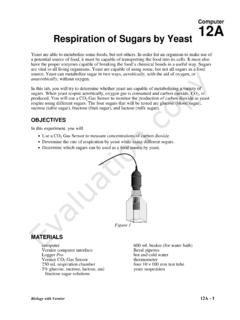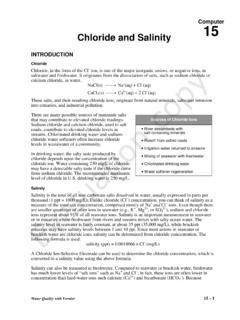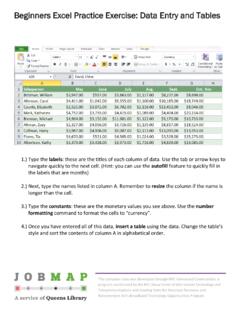Transcription of Quick RefeRence Manual
1 Quick RefeRence Manual ii TABLE OF CONTENTS. This guide first leads you through the basics of Logger Pro, including software installation procedures. You will learn how to collect data , manually enter data , and import data from Texas Instruments and Palm handhelds. From there, you will learn about the more advanced features of Logger Pro. Getting Started.. 1 Toolbar Guide.. 9. Introduction .. 4 Finding Your Way around Logger Pro Tutorials .. 5 Logger Pro Toolbar and Pages .. 10. Acquiring data The Sensors Dialog .. 11. Collect data .. 5 Managing Your Page and data .. 11. Manual data Entry .. 8 Analyze data .. 13. Import data .. 8 Printing .. 14. Remote data .. 8 Where to Next? .. 14. iii iv Getting started Logger Pro Requirements Macintosh To use Logger Pro, you will need a Windows or Place the Logger Pro CD in the CD-ROM drive of Macintosh computer.
2 See for your computer and double-click on the CD icon. detailed system requirements. For data collection Double-click the Install Logger Pro icon and you will need a data source such as a LabQuest, LabPro follow the instructions. or Go! Link with a Vernier sensor, or a Go! Motion or Go! Temp. Other compatible data sources are listed at Get Everything Ready Note: Logger Pro cannot be used with the ULI or To collect data with Logger Pro you will need either a Serial Box interface. Contact us for the availability LabPro or a Go! Link, with at least one sensor, or one of earlier versions of Logger Pro for older operating of several dedicated sensors listed below. systems or interfaces. A Vernier LabQuest interface: The Vernier LabQuest is a color Load Logger Pro touch-screen data -collection interface. It connects to your computer with its Windows included USB cable.
3 Place the Logger Pro CD in the A Vernier LabPro interface: CD-ROM drive of your computer. The Vernier LabPro is a multi-channel interface with its power supply and USB. I f you have Autorun enabled, the installation will or serial cable. launch automatically; otherwise launch from the CD. A Go! Link interface: The Logger Pro installer will start, and a series of Go! Link is a single-channel interface that dialog boxes will step you through the installation connects directly to a computer's USB port. of the Logger Pro software. We recommend that you accept the default directory. 1. and, at least one sensor: Or, Spectrometer Sensors are connected to the LabPro or Go! Link. The Vernier Spectrometer measures A Stainless Steel Temperature Probe is a good intensity and absorbance over many choice for initial testing of Logger Pro. The Voltage wavelengths simultaneously.
4 Probe included with the LabPro interface can also be used. Or, Garmin GPS. Or, Go! Temp Select Garmin GPS units can connect The Vernier Go!Temp is a temperature to Logger Pro for live data collection, probe that connects directly to the USB or the retrieval of stored tracks port of your computer. No interface or waypoints. is needed. This sensor comes with the Logger Lite software. Or, Ohaus Balances Or, Go! Motion Logger Pro allows you to collect mass data from select models of The Go! Motion is a motion detector Ohaus balances. that connects directly to a computer's USB port. Or, WDSS. The Wireless Dynamics Sensor System collects acceleration, force, and altitude data . It requires a Bluetooth- equipped computer. 2. initial Setup Note: The rst time that you run Logger Pro with your LabPro interface, a message may appear Note: The following setup instructions are for the notifying you of an update to the LabPro operating LabPro interface.
5 They are similar to the LabQuest system. Do not interrupt this update. and Go! Link interface instructions. Choose Logger Pro 3 Help from the Help menu for further details. Logger Pro can collect data from multiple interfaces The LabQuest Quick Start Guide contains information and devices. If Logger Pro has successfully detected speci c to LabQuest. these devices, you will see the device icon (see figure below). Also, if an auto-ID sensor is attached, the Before launching logger Pro, current sensor reading will appear below the toolbar you should: (as shown in the figure). Some devices, such as WDSS, Power the LabPro using the AC GPS or Ohaus balances, require Manual connection in power supply or AA batteries. Logger Pro. Choose Connect Interface (device name). from the Experiment menu to connect. Connect a sensor to LabPro. Connect the USB or serial cable to LabPro.
6 Attach the other end of the interface cable to any unused serial port or USB. port on your computer. Start logger Pro In the gure above, a Go!Link, Go!Temp, LabPro and Ohaus balance are connected to the computer. Locate the Logger Pro icon and double-click on it. You have now successfully set up your equipment and Mac OS X users can find the icon in the Logger Pro installed Logger Pro. Keep reading for instructions on folder created in Applications during installation. the various ways to collect and obtain data . You will also learn how to use Logger Pro's powerful features, such as data analysis, movies, and customizing your experiments. 3. Introduction Logger Pro is a program that allows you to collect Use video capture to record video streaming from and analyze data from Vernier LabQuest, LabPro, digital camera or webcam. Go! Link, Go!Temp, Go!
7 Motion, Vernier/Ocean Optics Spectrometers, the Vernier WDSS, and Ohaus balances. The Help guide in the program provides complete details Among its many features, data may be manually about Logger Pro. Tutorials are also included. Select entered from the keyboard, pasted from the clipboard, Open from the File menu to access them. or retrieved from a file saved on disk. Logger Pro is also a document creator, with the ability to include several pages in one document With Logger Pro you can also: Perform data analysis, such as statistical analysis, curve fitting, and calculated columns. Add pictures to lab reports. Add movies and synchronize movies with data collection. Import data collected with TI handhelds. Import data collected with Palm OS handhelds. Manually enter data . Export data to excel or other spreadsheets. H. ave students draw a prediction on a graph and see how well the experimental data matches it.
8 U. se video analysis to create a graphical representation of the motion you see in a movie. 4. TuTORialS acQuiRinG data There are tutorials that cover many Logger Pro features You can acquire data in Logger Pro by collecting data and menus. To access, choose Open from the File menu, from a source, importing from a compatible device, or then open the Tutorials folder: manually entering data from the keyboard. Getting Started Motion Measurement Stats, Tangents, Linearization collect data Integrals (Parts 1 and 2) Before collecting data , perform the Initial Setup steps for your interface. These steps are outlined on page 3. Events with Entry Manual data Entry of this guide. Curve Fitting Video Analysis All you need to do is open the tutorial file you want to con gure logger Pro for Your try out, and then follow the on-screen instructions in experiment that file.
9 There are several ways to set up Logger Pro for an experiment. Most are automatic. The extensive Help in logger Pro provides detailed instructions for use of the program. Auto-ID Sensors With auto-ID sensors, all you The answer you are looking for may be just a need to do is connect the sensor to one of the mouse click or two away! LabPro channels and start Logger Pro software. The sensor will be identified, and default data -collection parameters loaded for that sensor. You are ready to click the button and begin data collection! Probes & sensors experiment les If you are using an older Vernier sensor that is not auto-ID, or if you want to use some other specially configured file, you will need the Probes & Sensors folder. Choose Open from the File menu, and open the Probes & Sensor folder. There you will find a folder 5. for each of the Vernier sensors.
10 Open up a file with now You are Ready to collect data a name that best fits the data collection you want to perform. Click . Logger Pro will begin plotting data in the graph window. Tip: Normally, the data collection stops Vernier lab book experiment les When you at the time indicated on the time axis. You can stop the choose Open from the File menu, you will see a series data collection early by clicking . If you discover you of folders with Vernier lab book experiment files, such want the data collection to go even longer, you can add as Biology with Computers, etc. Each of these folders additional time by choosing Extend Collection from the contains 30-40 experiment files, each corresponding Experiment menu. to an experiment in each of our lab books. Now that you have collected data , there are many things Sensor dialog This dialog, called by clicking the you can do with it.
